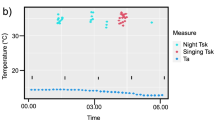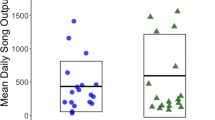Abstract
Sexually selected displays, such as male passerine bird song, are predicted to be costly. However, most measurements calculated the rate of oxygen consumption during singing using respirometry have shown that bird song has a low energetic cost. Since birds are reluctant to sing when enclosed inside a respirometry chamber, the energetic cost of singing could differ from that under more normal circumstances. We used heat transfer modelling, based on thermal images, to estimate the energetic cost of singing by canaries (Serinus canaria) that were not enclosed in respirometry chambers. Metabolic rate calculated from heat transfer modelling was 0.70±0.02 W (N=10 birds) during singing, which was 14±5% greater than during standing (0.62±0.02 W). The energetic cost of singing did not differ significantly from that measured previously using respirometry when we took into account that birds sang for a greater proportion of the time during the current experiments. These conclusions were not sensitive to potential errors in the heat transfer model. Heat transfer modelling would be especially useful to obtain measurements of the energetic cost of activities that animals do not perform readily inside respirometry chambers, such as singing in birds.



Similar content being viewed by others
Abbreviations
- σ:
-
Stefan–Boltzmann constant (5.67×10−8 W m−2 K−4)
- ε:
-
Bird emissivity (dimensionless)
- A :
-
Surface area (m2)
- c :
-
Specific heat capacity of air (J ml−1 °C−1)
- h :
-
Convective heat transfer coefficient (W m−2 K−1)
- P met :
-
Metabolic power (W)
- q conv :
-
Heat transfer by convection (W)
- q evap,cut :
-
Cutaneous evaporative heat transfer (W)
- q evap,resp :
-
Respiratory evaporative heat transfer (W)
- q exhaled :
-
Heat loss in exhaled air (W)
- q rad :
-
Heat transfer by radiation (W)
- RH:
-
Relative humidity (%)
- T a :
-
Ambient temperature (°C)
- T ex :
-
Temperature of exhaled air (°C)
- T s :
-
Bird surface temperature (°C)
References
Andersson M (1994) Sexual selection. Princeton University Press, Princeton
Butler PJ, Bishop C (2000) Flight. In: Whittow GC (ed) Sturkie’s avian physiology. Academic, London, pp 391–436
Catchpole CK, Slater PJB (1995) Bird song biological themes and variations. Cambridge University Press, Cambridge
Cossins AR, Bowler K (1987) Temperature biology of animals. Chapman and Hall, London
Darwin C (1871) The descent of man and selection in relation to sex. John Murray, London
Eberhardt LS (1994) Oxygen consumption during singing by male Carolina wrens Thryothorus ludovicianus. Auk 111:124–130
Fisher RA (1930) The genetical theory of natural selection. Clarendon, Oxford
Franz M, Goller F (2003) Respiratory patterns and oxygen consumption in singing zebra finches. J Exp Biol 206:967–978
Gates DM (1980) Biophysical ecology. Springer, Berlin Heidelberg New York
Gil D, Gahr M (2002) The honesty of bird song: multiple constraints for multiple traits. TREE 17:133–141
Hartley RS, Suthers RA (1989) Airflow and pressure during canary song: direct evidence for mini-breaths. J Comp Physiol A 165:15–26
Hill AV (1938) The heat of shortening and the dynamic constants of muscle. Proc R Soc Lond B 126:136–195
Hill R, Beaver DL, Veghte JH (1980) Body surface temperatures and thermoregulation in the black-capped chickadee (Parus atricapillus). Physiol Zool 53:305–321
Holman JP (2002) Heat transfer, 9th edn. McGraw Hill, New York
Kahl MP (1963) Thermoregulation in the wood stork with special reference to the role of the legs. Physiol Zool 36:141–151
Kokko H, Brooks R, Jennions MD, Morley J (2003) The evolution of mate choice and mating biases. Proc Roy Soc Lond B 270:653–664
Kotiaho JS (2001) Costs of sexual traits: a mismatch between theoretical considerations and empirical evidence. Biol Rev 76:365–376
Kvist A, Klaassen J, Lindström A (1998) Energy expenditure in relation to flight speed: what is the power of mass loss rate estimates? J Avian Biol 29:485–498
Kvist A, Lindström A, Green M, Piersma T, Visser GH (2001) Carrying large fuel loads during sustained bird flight is cheaper than expected. Nature 413:730–732
Lambrechts MM (1996) Organization of bird song and constraints on performance. In: Kroodsma DE, Miller EH (eds) Ecology and evolution of acoustic communication in birds. Cornell University Press, Ithaca, 305–320
Martineau L, Larochelle J (1988) The cooling power of pigeon legs. J Exp Biol 136:193–208
Norberg UM (1990) Vertebrate flight. Springer, Berlin Heidelberg New York
Oberweger K, Goller F (2001) The metabolic cost of birdsong production. J Exp Biol 204:3379–3388
Phillips PK, Sanborn AF (1994) An infrared thermographic study of surface temperature in three ratites: ostrich emu and double-wattled cassowray. J Therm Biol 19:423–430
Schmidt-Nielsen K (1997) Animal Physiology: Adaptation and Environment. Cambridge University Press, Cambridge
Schmidt-Nielsen K, Hainsworth FR, Murrish DE (1970) Counter-current heat exchange in the respiratory passages: effect on water and heat balance. Resp Physiol 9:263–276
Speakman JR, Ward S (1998) Infrared thermography: principles and applications. Zool Anal Complex Syst 101:224–232
Steen I, Steen JB (1965) The importance of the legs in the thermoregulation of birds. Acta Physiol Scand 63:285–291
Thomas RJ (2002) The costs of singing in nightingale. Anim Behav 63:959–966
Thomas RJ, Cuthill IC, Goldsmith AR, Cosgrove DF, Lidgate JC, Burdett Proctor SL (2003) The trade-off between singing and mass gain in a daytime-singing bird the European robin. Behavior 140:387–404
Verhulst S, Wiersma P (1997) Is begging cheap? Auk 114:134–134
Walsberg GE, King JR (1978) The relationship of the external surface area of birds to the skin surface area and body mass. J Exp Biol 76:185–189
Ward S, Rayner JMV, Möller U, Jackson DM, Nachtigall W, Speakman JR (1999) Heat transfer from starlings Sturnus vulgaris during flight. J Exp Biol 202:1589–1602
Ward S, Möller U, Rayner JMV, Jackson DM, Bilo D, Nachtigall W, Speakman JR (2001) Metabolic power mechanical power and efficiency during wind tunnel flight by the European starling Sturnus vulgaris. J Exp Biol 204:3311–3322
Ward S, Speakman JR, Slater PJB (2003) The energy cost of song in the canary Serinus canaria. Anim Behav 66:893–902
Ward S, Lampe HM, Slater PJB (2004a) Singing is not energetically demanding for pied flycatchers Ficedula hypoleuca. Behav Ecol 15:477–484
Ward S, Möller U, Rayner JMV, Jackson DM, Nachtigall W, Speakman JR (2004b) Metabolic power of European starlings Sturnus vulgaris during flight in a wind tunnel estimated from heat transfer modelling doubly labelled water and mask respirometry. J Exp Biol 207:4291–4298
Williams JB (1996) A phylogenetic perspective of evaporative water loss in birds. Auk 113:457–472
Zahavi A (1975) Mate choice: a selection for a handicap. J Theor Biol 53:205–214
Acknowledgements
We are very grateful to Isobel Maynard, Vicki Murray and Andrew Oliver for their help in caring for the canaries, to Murray Coutts, Keith Haynes and Henry Rae for building the heated model bird, to the EPSRC Equipment Loan Pool for use of the thermal imaging equipment, to Peter Anthony for technical assistance with thermal imaging, to Stephen Walley for the sample of Duracon paint, to Franz Goller, John Speakman and Rod Suthers for their useful discussions, to Franz Goller for permission to use unpublished data and to the BBSRC for funding our work. The experiments complied with the “Principles of animal care” publication no. 86-23, revised in 1985 of the National Institute of Health and with the current laws and advice on animal care in the UK, where the experiments were performed.
Author information
Authors and Affiliations
Corresponding author
Rights and permissions
About this article
Cite this article
Ward, S., Slater, P.J.B. Heat transfer and the energetic cost of singing by canaries Serinus canaria . J Comp Physiol A 191, 953–964 (2005). https://doi.org/10.1007/s00359-005-0022-4
Received:
Revised:
Accepted:
Published:
Issue Date:
DOI: https://doi.org/10.1007/s00359-005-0022-4




